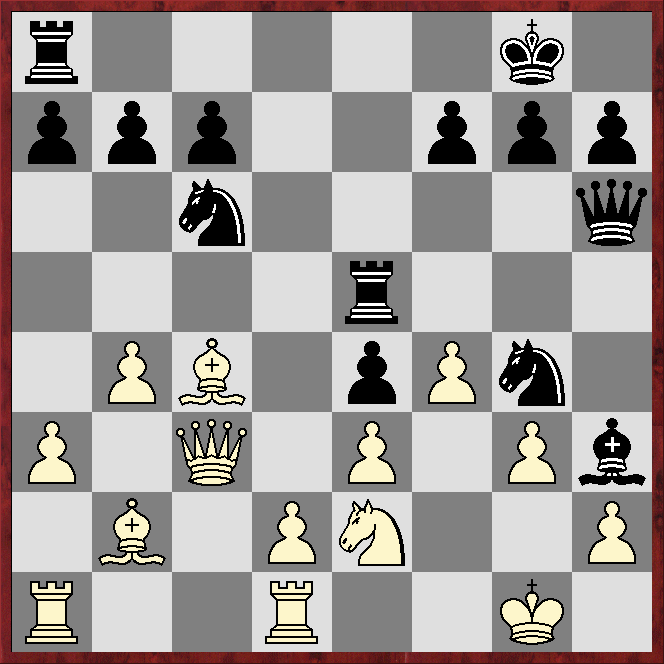FACED a Ukrainian.
 |
| Around almost every corner lies a church |
Boris Gurtovoi (1701) - Spanton (1852)
English
1.e3 e5 2.c4 Nf6 3.Nc3 Bb4
Black is effectively playing the white side of the Rossolimo Variation of the Sicilian but with a tempo (e3) less.
4.Qc2!?
Most popular is 4.Nge2, just as in the Rossolimo in a similar position Black usually plays ...Nge7.
4...0-0 5.a3 Bxc3!?
Giving up the bishop-pair is the normal continuation. The idea, I guess, is Black has a slight lead in development, and if White recaptures with a pawn it will mean doubled pawns and difficulties in developing the dark-square bishop. If, on the other hand, White recaptures with the queen, which is the main continuation and is played in the game, White will still require at least two tempi to get the dark-square bishop developed, and the queen may be subjected to a hit from a black knight on d5.
6.Qxc3 Re8 7.g3?!
It is doubtful if White can afford the time to play this.
*****
*****
*****
*****
7...d5!?
Opening the position when the opponent has the bishop-pair is usually inadvisable, except when the player doing the opening is ahead on development, the idea being to take advantage of the extra development to disorganise the opponent. Here Black has castled and developed a knight and rook, while White has only the queen developed. In addition it is Black to move, so I like to think of the development-tempi count in such a situation as being 3.5-1 in Black's favour (the 0.5 for being on move). Naturally the specifics of the position must be taken into account. Komodo13.02 reckons the text is the best move in the position; Stockfish15 rates it and 7...Nc6 as equally good.
8.cxd5
On 8.Bg2 I planned 8...d4, which is strong, as is the engines' 8...Nc6.
8...Qxd5
Hitting the white queen with 8...Nxd5 is also enough for an edge, but the text is better.
9.f3 Nc6 10.Bc4!?
The engines agree developing with tempo like this is best. If 10.Bg2 both 10...Bf5 and 10...e4 are strong.
10...Qd6 11.b4 Nd4!?
*****
*****
*****
*****
12.Kf2?
Clearly not 12.exd4?? exd4+, but best, according to the engines, is 12.Bb2, although they reckon Black remains on top.
Clearly not 12.exd4?? exd4+, but best, according to the engines, is 12.Bb2, although they reckon Black remains on top.
*****
*****
*****
*****
12...Nc6?
Missing 12...Nxf3!, when 13.Nxf3 Ne4+ and 13.Kxf3 Qc6+ are killers. Best seems to be 13.d3, but 13...Ng5 leaves Black with an overwhelming advantage, according to the engines. Also strong is 12...b5.
13.Ne2?!
Probably not best. The engines recommend either 13.b5, eg 13...Ne7 14.e4, or 13.d3, eg 13...Be6 14.Ne2, in each case with advantage to Black.
13...e4 14.f4
Not 14.fxe4?? Nxe4 and 15...Nxc3.
14...Bh3!? 15.Rd1?!
Overprotecting d2 and trying to set-up counterplay, but it was almost certainly necessary to take Black's kingside threats more seriously. One line given by the engines runs 15.Bb2 Ng4+ 16.Ke1 Qh6 17.b5 Ne7 18.Qb3 Rf8 19.Qb4 Nf5 20.Qc5, albeit they prefer Black after 20...Nd6.
15...Ng4+ 16.Kg1 Qh6 17.Bb2
*****
*****
*****
*****
17...Re5??
Best, according to the engines, is patient build-up with 17...Rad8 or 17...Ne7.
*****
*****
*****
*****
18.Nd4??
Stockfish15 gives 18.fxe5 Ncxe5 19.Qxe5! Nxe5 20.Bxe5, when White has rook, knight and bishop (plus the bishop-pair) for queen and pawn. Komodo13.02 prefers 18.Bxf7+!? Kxf7 19.fxe5, when 19...Ncxe5?? fails to 20.Qxc7+ etc.
18...Nxh2??
The simple 18...Nxd4 wins, eg 19.Qxd4 Nxh2 with a massive attack, or 19.exd4 Rh5, again winning.
19.Nxc6 Nf3+?!
The engines reckon 19...bxc6 and 19...Rh5 are roughly equal.
20.Kf2 Bf1??
Less clear, but possibly favouring White, is 20...Rh5, eg 21.Ne7+ Kf8 22.Qxg7+!? Qxg7 23.Bxg7 Kxg7 24.Rh1.
The game finished:
21.Bxf1 Rh5 22.Bg2 bxc6 23.Rh1 Rd8 24.Rxh5 Rxd2+ 25.Qxd2 1-0





No comments:
Post a Comment